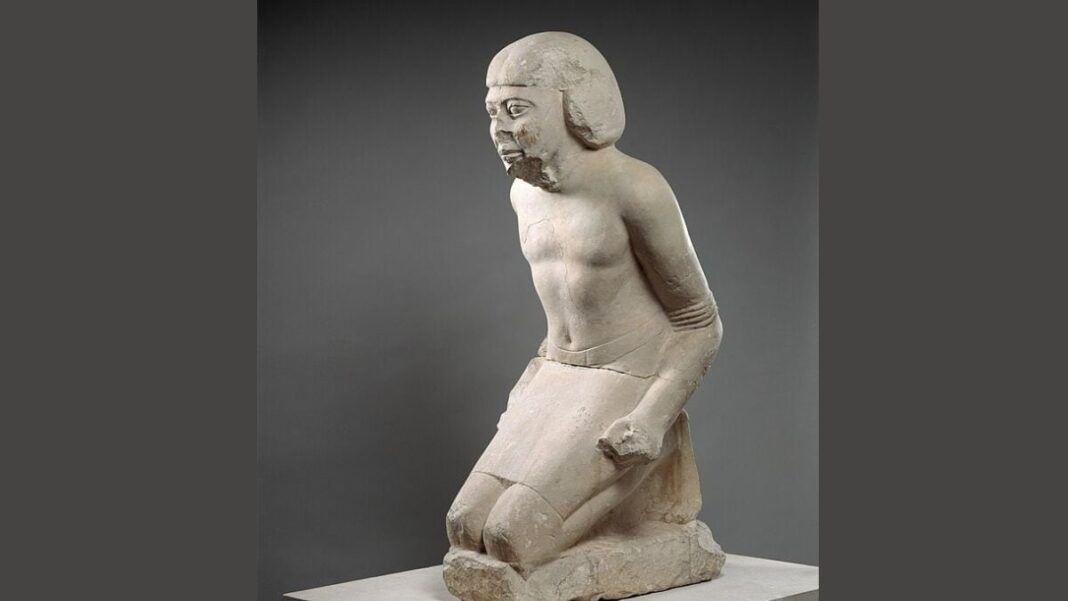"A Glimpse into Cultural Integration: Unveiling the Secrets of a 2,300-Year-Old Dwarf Statuette from Alexandria, Egypt"
In the bustling streets of Alexandria, Egypt, a remarkable discovery has shed light on the perception of dwarves during the intriguing Ptolemaic period. Imagine stumbling upon a 4-inch marble statuette, dating back over two millennia, that captures the essence of a muscular, nude dwarf in graceful motion. Despite the missing limbs and part of the head, the intricate craftsmanship of this ancient relic speaks volumes about the skilled artisans of that era. Now resting in the prestigious Metropolitan Museum of Art in New York City, this miniature masterpiece bridges the gap between Egyptian and Greek artistic influences, offering a glimpse into a bygone era of cultural exchange and artistic fusion.
The Story So Far: Unraveling the Mysteries of a Timeless Artifact
Embark on a journey through time as we delve into the rich tapestry of Ptolemaic artistry, where Greek aesthetics intertwine with Egyptian cultural nuances to create a harmonious blend of creativity. Step into the world of a dwarf depicted in a dance, a symbol of societal importance that defies the stereotypes prevalent in Greek art. Explore the historical significance of dwarves in ancient Egypt, revered for their association with the powerful god Bes, a guardian of families and women in childbirth. Witness the evolution of cultural integration through the lens of this captivating statuette, offering a unique perspective on body diversity and societal acceptance during a transformative period in history.
Unveiling the Depths: A Detailed Exploration of Cultural Dynamics
Dive deeper into the intricate details of this ancient artifact, where Greek classical nudity and Hellenistic realism intertwine with Egyptian artistic sensibilities to create a masterpiece that transcends time. Discover the societal roles of dwarves in ancient Egypt, where their close connection to the revered god Bes elevated their status within noble households and royal circles. Unravel the symbolic significance of Bes as a dancer and tambourine player, embodying strength and protection in the rich tapestry of Egyptian mythology. Explore the broader tradition of valuing diverse body types in Egyptian society, setting it apart from its ancient counterparts and offering a fresh perspective on cultural dynamics in a period of profound change.
Conclusion: Reflecting on the Legacy of a Timeless Treasure
As we bid farewell to this captivating journey through the annals of history, let us pause to reflect on the enduring legacy of the 2,300-year-old dwarf statuette from Alexandria. This remarkable artifact not only offers a window into the cultural integration of the Ptolemaic era but also serves as a testament to the timeless beauty of human creativity and artistic expression. May its presence in the hallowed halls of the Metropolitan Museum of Art continue to inspire generations to come, reminding us of the rich tapestry of cultural exchange that defines our shared human experience.
Frequently Asked Questions
- What is the significance of the dwarf statuette discovered in Alexandria, Egypt?
- The dwarf statuette offers insights into the perception of dwarves during the Ptolemaic period, showcasing a blend of Greek and Egyptian artistic traditions.
- How does the statuette reflect cultural integration during the Ptolemaic era?
- The statuette combines elements from Greek art with Egyptian aesthetics, highlighting the cultural exchange that characterised the Ptolemaic dynasty.
- What role did dwarves play in ancient Egyptian society?
- Dwarves were highly regarded in ancient Egypt, often serving in noble households and pharaohs’ retinues due to their association with the god Bes.
- Who was the god Bes, and why was he significant in Egyptian mythology?
- Bes was a short, muscular god who served as a protector of families and women in childbirth, symbolising strength and guardianship in Egyptian culture.
- What does the depiction of the dwarf with a percussion instrument signify?
- The depiction aligns with the cultural significance of the god Bes, who was known as a dancer and tambourine player in Egyptian mythology.
- How does the statuette contribute to our understanding of diverse body types in ancient Egypt?
- The statuette reflects a broader tradition of valuing diverse body types in Egyptian society, showcasing a unique approach to body diversity in the ancient world.
- What sets the depiction of dwarves in Ptolemaic art apart from Greek caricatures?
- Unlike exaggerated caricatures of dwarves in Greek art, the Ptolemaic statuette portrays a dwarf engaged in dance, suggesting a significant societal role.
- Why is the cultural exchange of the Ptolemaic era considered transformative in history?
- The cultural exchange between Greek and Egyptian traditions during the Ptolemaic era led to a unique fusion of artistic styles and societal values, shaping the cultural landscape of the time.
- How does the craftsmanship of the statuette reflect the skill of ancient artisans?
- Despite missing limbs, the statuette showcases intricate craftsmanship and a highly skilled rendering of human anatomy, highlighting the expertise of ancient artisans.
- What broader insights can be gleaned from the 2,300-year-old dwarf statuette?
- The statuette offers a profound understanding of cultural dynamics, societal roles, and artistic fusion during a transformative period in history, enriching our knowledge of ancient civilizations.
Tags: Alexandria, Egypt, Ptolemaic era, dwarf statuette, Greek art, Egyptian culture
- The statuette offers a profound understanding of cultural dynamics, societal roles, and artistic fusion during a transformative period in history, enriching our knowledge of ancient civilizations.

